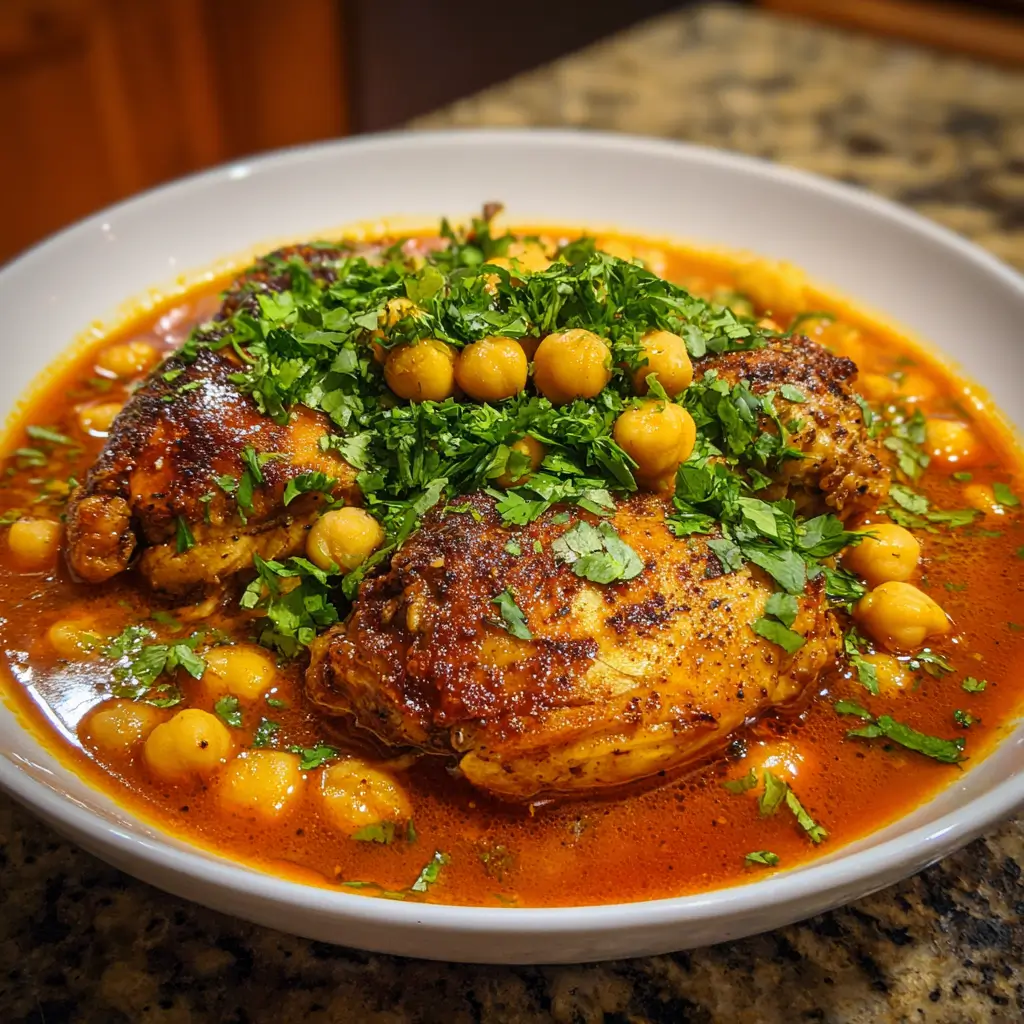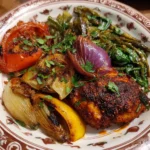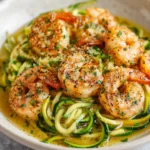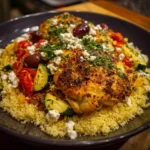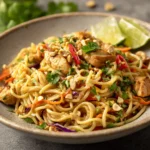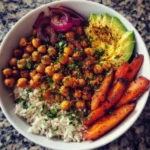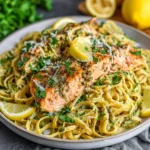Introduction
Moroccan Chicken and Chickpea Stew is a soul-warming, aromatic dish that embodies the essence of North African cuisine. Known for its rich tapestry of spices, tender chicken, and hearty legumes, this stew is both nourishing and deeply flavorful. It’s a traditional one-pot meal commonly enjoyed in Moroccan households, especially during cooler months or on special occasions such as family gatherings and religious holidays. The combination of slow-simmered chicken, earthy chickpeas, and sweet vegetables creates a harmonious balance that delights the palate and comforts the spirit. Whether served over fluffy couscous or with warm crusty bread, this dish invites you to savor every spoonful.
The History
The roots of Moroccan Chicken and Chickpea Stew stretch back centuries, deeply embedded in the culinary traditions of Morocco—a country where food is not just sustenance but an expression of culture, hospitality, and heritage. Influences from Berber, Arab, Andalusian, and Mediterranean cuisines have all played a role in shaping Moroccan cooking. The use of preserved lemons, olives, and complex spice blends like ras el hanout reflects the country’s long history of trade across the Sahara and Mediterranean. Chickpeas have been cultivated in North Africa since ancient times, valued for their protein content and versatility. When combined with chicken—a more accessible meat than lamb or beef in many regions—they formed the basis of a nourishing, economical meal. Over time, this humble stew evolved into a celebrated dish, often prepared in a tagine (a conical clay pot) that enhances flavor through slow, even cooking. Today, it remains a staple in Moroccan homes and a favorite among global food enthusiasts seeking authentic, spiced comfort food.
Ingredients Breakdown
Understanding each ingredient in Moroccan Chicken and Chickpea Stew helps appreciate the depth of flavor it brings to the table:
- Chicken: Traditionally, bone-in chicken thighs or drumsticks are used for their rich flavor and ability to stay moist during slow cooking. Boneless pieces can be substituted for quicker preparation, though bones contribute significantly to the broth’s richness.
- Chickpeas: These legumes add heartiness and plant-based protein. Canned chickpeas offer convenience, while dried ones—soaked and cooked—provide superior texture and flavor.
- Onions and Garlic: Forming the aromatic base, they build a savory foundation essential to any stew.
- Tomatoes: Fresh tomatoes or canned crushed tomatoes lend acidity and body to the sauce, helping to balance the warmth of the spices.
- Carrots and Sweet Potatoes: These root vegetables add natural sweetness and color, softening beautifully during the simmering process.
- Olive Oil: Used for sautéing, olive oil imparts a fruity note and supports the dispersion of fat-soluble spices.
- Spices: A blend of ground cumin, coriander, turmeric, cinnamon, ginger, and paprika creates the signature warmth. Many recipes also include ras el hanout, a complex Moroccan spice mix that may contain up to 30 different ingredients, including cardamom, clove, nutmeg, and rose petals.
- Preserved Lemons: A quintessential Moroccan ingredient, these salt-cured lemons contribute a bright, tangy, umami-rich flavor that elevates the entire dish.
- Olives: Green or black olives add a briny contrast, balancing the sweetness of the vegetables and the warmth of the spices.
- Chicken Broth or Water: Used to create the stewing liquid; homemade broth intensifies the flavor profile.
- Fresh Herbs: Cilantro and parsley are typically added at the end for freshness and a pop of green color.
Step-by-Step Recipe
- Prepare Ingredients: Chop onions, mince garlic, dice carrots and sweet potatoes, slice preserved lemon (rinsing off excess salt), and drain chickpeas if using canned. Pat chicken pieces dry and season lightly with salt and pepper.
- Sear the Chicken: Heat 3 tablespoons of olive oil in a large Dutch oven or heavy-bottomed pot over medium-high heat. Sear chicken pieces until golden brown on both sides. Remove and set aside.
- Sauté Aromatics: In the same pot, add onions and cook until translucent (about 5 minutes). Stir in garlic and cook for another minute until fragrant.
- Bloom the Spices: Add cumin, coriander, turmeric, cinnamon, ginger, paprika, and a pinch of cayenne (if desired). Stir constantly for 1–2 minutes to release essential oils and deepen flavor without burning.
- Add Tomatoes and Vegetables: Stir in crushed tomatoes, carrots, and sweet potatoes. Mix well to coat vegetables with the spiced base.
- Return Chicken and Add Liquids: Place seared chicken back into the pot. Add chickpeas, preserved lemon, olives, and enough chicken broth to just cover the ingredients (about 4 cups).
- Simmer Gently: Bring to a gentle boil, then reduce heat to low. Cover and simmer for 45 minutes to 1 hour, stirring occasionally, until chicken is tender and vegetables are soft.
- Taste and Adjust: Season with salt and pepper as needed. If the stew is too thin, uncover and simmer for an additional 10–15 minutes to thicken. For a richer taste, stir in a tablespoon of honey or a splash of lemon juice.
- Finish with Herbs: Just before serving, stir in chopped cilantro and parsley to brighten the dish.
- Serve: Ladle hot stew into bowls, ideally over steamed couscous, quinoa, or with warm pita bread on the side.
Tips
- Use Bone-In Chicken: Bones enhance flavor and moisture. If using boneless, reduce cooking time by 15–20 minutes to avoid dryness.
- Toast Your Spices: Blooming spices in oil unlocks their full potential. Be careful not to burn them—low and slow works best.
- Soak Dried Chickpeas Overnight: If using dried chickpeas, soak them for at least 8 hours and boil separately until tender before adding to the stew.
- Rinse Preserved Lemon: Always rinse preserved lemon under cold water to remove excess salt. Only the peel is used—discard the bitter pulp.
- Make Ahead Flavor Boost: This stew tastes even better the next day. Prepare it a day in advance and reheat gently before serving.
- Low and Slow Simmer: Avoid boiling vigorously; a gentle simmer ensures tender chicken and well-integrated flavors.
- Balance Acidity: Adjust lemon juice or preserved lemon to taste. Too much can overpower, while too little dulls the brightness.
- Thicken Naturally: Mash some chickpeas against the pot wall to naturally thicken the stew without flour or cornstarch.
Variations and Customizations
- Vegan Version: Omit chicken and use vegetable broth. Increase chickpeas or add lentils and mushrooms for a meaty texture. Perfect for a hearty plant-based stew.
- Lamb or Beef Substitute: Replace chicken with cubed lamb or beef for a deeper, gamier flavor. Brown well and extend cooking time to ensure tenderness.
- Additional Vegetables: Zucchini, bell peppers, turnips, or butternut squash can be added for more variety and seasonal appeal.
- Spice Level: Adjust heat with more cayenne, harissa paste, or fresh chili peppers. For mild versions, omit spicy elements entirely.
- Citrus Swap: If preserved lemons aren’t available, use zest of one lemon plus 1 teaspoon of kosher salt as a substitute.
- Coconut Milk Twist: Add ½ cup of coconut milk for a creamy, slightly sweet variation inspired by Moroccan coastal influences.
- Herb Variations: Try mint instead of cilantro for a refreshing twist, or add saffron threads for luxury and color.
- Grain Integration: Turn it into a complete meal by adding bulgur, barley, or rice directly to the stew during the last 20 minutes of cooking.
Health Considerations and Nutritional Value
Moroccan Chicken and Chickpea Stew is not only delicious but also nutritionally balanced, offering a blend of lean protein, complex carbohydrates, fiber, and healthy fats. Here’s a breakdown of its health benefits:
- High in Protein: Chicken and chickpeas provide high-quality protein essential for muscle repair and satiety.
- Fiber-Rich: Chickpeas and vegetables contribute substantial dietary fiber, supporting digestion and blood sugar regulation.
- Healthy Fats: Olive oil offers monounsaturated fats, known to support heart health and reduce inflammation.
- Low Glycemic Index: The combination of legumes and non-starchy vegetables makes this dish suitable for those managing diabetes.
- Vitamin and Mineral Dense: Carrots supply beta-carotene (vitamin A), sweet potatoes offer vitamin C and potassium, while garlic and onions contain immune-boosting compounds.
- Antioxidant Spices: Turmeric contains curcumin, a powerful anti-inflammatory agent. Cinnamon helps regulate blood sugar, and ginger aids digestion.
- Lower Sodium Option: Use low-sodium broth and limit added salt, especially when using preserved lemons and olives which are naturally salty.
- Portion Control: Serve moderate portions with whole grains to avoid overeating. One serving (1.5 cups) typically ranges between 300–400 calories depending on ingredients.
This stew supports weight management, cardiovascular health, and overall wellness when consumed as part of a balanced diet. It’s ideal for meal prepping due to its stability and improved flavor over time.
Ingredients
- 6 pieces bone-in chicken thighs or drumsticks (about 2 lbs / 900g)
- 1 can (15 oz / 425g) chickpeas, drained and rinsed (or 1.5 cups cooked dried chickpeas)
- 2 tablespoons olive oil
- 1 large yellow onion, finely chopped
- 4 cloves garlic, minced
- 2 medium carrots, peeled and diced
- 1 small sweet potato, peeled and cubed
- 1 can (14.5 oz / 400g) crushed tomatoes
- 1 preserved lemon, pulp removed and peel sliced
- ½ cup green or black olives, pitted and halved
- 1 teaspoon ground cumin
- 1 teaspoon ground coriander
- 1 teaspoon ground turmeric
- 1 teaspoon ground cinnamon
- ½ teaspoon ground ginger
- ½ teaspoon smoked paprika
- ¼ teaspoon cayenne pepper (optional)
- 4 cups low-sodium chicken broth
- Salt and freshly ground black pepper to taste
- ¼ cup chopped fresh cilantro
- ¼ cup chopped fresh parsley
- 1 tablespoon honey (optional, for balance)
Directions
- Season chicken with salt and pepper. Heat olive oil in a large heavy pot or Dutch oven over medium-high heat. Sear chicken in batches until golden brown on both sides, about 4–5 minutes per side. Remove and set aside.
- In the same pot, add onions and sauté until soft and translucent, about 5 minutes. Add garlic and cook for 1 minute until fragrant.
- Stir in cumin, coriander, turmeric, cinnamon, ginger, paprika, and cayenne. Cook for 1–2 minutes, stirring constantly, until spices are aromatic.
- Add crushed tomatoes, carrots, and sweet potatoes. Stir well to combine and cook for 2 minutes to meld flavors.
- Return chicken to the pot. Add chickpeas, preserved lemon, olives, and chicken broth. Liquid should nearly cover the ingredients.
- Bring to a boil, then reduce heat to low. Cover and simmer gently for 45 minutes to 1 hour, or until chicken is cooked through and vegetables are tender.
- Taste and adjust seasoning. Add salt, pepper, honey, or a splash of lemon juice as needed for balance.
- If stew is too thin, uncover and simmer for 10–15 minutes to reduce. For a creamier texture, lightly mash some chickpeas with a spoon.
- Just before serving, stir in fresh cilantro and parsley.
- Serve hot over couscous, with crusty bread, or alongside a green salad.
FAQ
Can I make this stew in a slow cooker?
Yes! After searing the chicken and sautéing the aromatics and spices, transfer everything to a slow cooker. Add remaining ingredients and cook on low for 6–8 hours or high for 3–4 hours.
What is ras el hanout, and can I use it?
Ras el hanout is a Moroccan spice blend meaning “top of the shop,” indicating the finest spices a vendor offers. You can substitute 1–2 teaspoons for individual spices or use it in addition to them for deeper complexity.
Where can I find preserved lemons?
They’re available in Middle Eastern markets, gourmet grocery stores, or online. You can also make them at home by packing lemon quarters in salt and letting them ferment for 3–4 weeks.
Can I freeze this stew?
Absolutely. Cool completely and store in airtight containers for up to 3 months. Reheat on the stove with a splash of water or broth to refresh consistency.
Is this stew gluten-free?
Yes, provided all ingredients (especially broth and preserved lemons) are certified gluten-free. Always check labels if allergies are a concern.
How do I store leftovers?
Refrigerate in a sealed container for up to 4 days. Flavors deepen over time, making leftovers even more delicious.
Can I use skinless chicken breasts?
You can, but they may become dry. Reduce cooking time to 25–30 minutes and consider adding them halfway through simmering.
What can I serve with this stew?
Traditional pairings include couscous, crusty bread, flatbreads, or a simple green salad with lemon vinaigrette. Harissa or yogurt can be served on the side for extra flavor.
Summary
Moroccan Chicken and Chickpea Stew is a fragrant, nutrient-dense dish that combines tender chicken, creamy chickpeas, and vibrant spices simmered to perfection. Hearty, healthy, and steeped in cultural tradition, it’s a meal that warms both body and soul.
